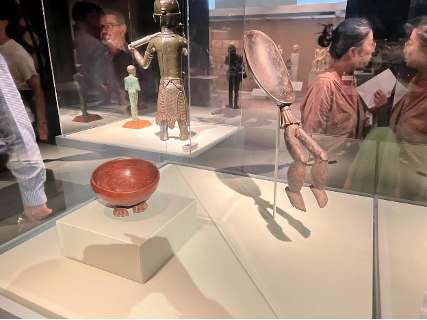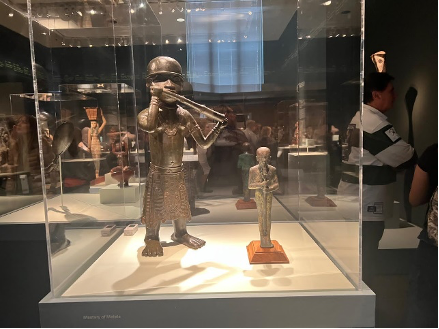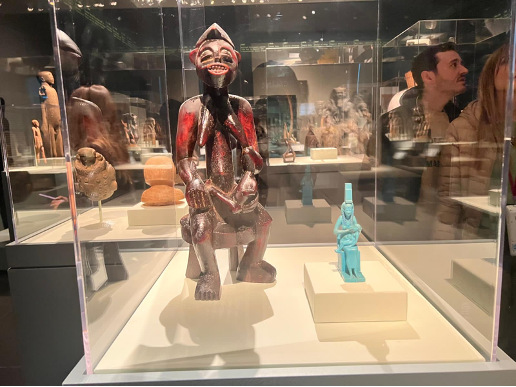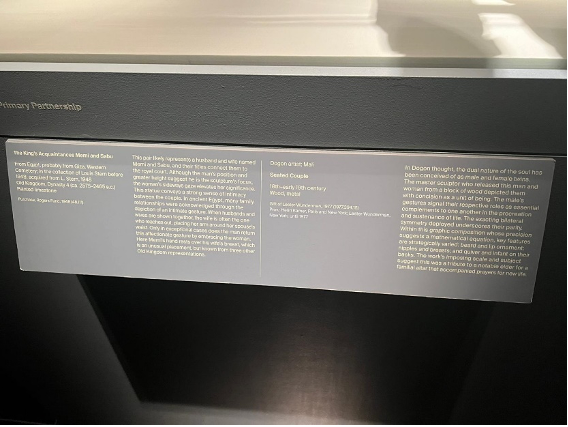The art world is diverse, with numerous styles, movements, and traditions spanning time and space. One of the best-known artwork collections is African Civilization Art, with images of various art forms, from ancient Egyptian and Nubian sculptures to elaborate masks and textiles of West and Central Africa, from current South African paintings and sculptures to contemporary works by African diaspora artists.[1]. The collection encompasses a wide range of artworks created by numerous civilizations and individuals across the African continent with a complex artistic legacy, thanks to Cheikh Anda Diop, who rooted the need to e-assess ancient Africa’s contributions to humanity. The display spans over 5,000 years, from Egypt’s pre-dynastic period to the twentieth-century[2]. The exhibition’s central theme is to provide a detailed and informative glimpse into Africa’s diverse artistic traditions and cultural achievements.

One of the unique aspects of the display that make it stand out is the pairing of objects. The reason that underpins the pairing of objects is that they were created in different times and places, and pairing them showcases the continuity and diversity of African culture primarily and also challenges the belief of a monolithic African identity. Additionally, the different scales of the paired objects aim to draw the viewers’ attention to the details and make them contrast and juxtapose the object’s qualities. Also, pairing object of different scales with different cultural settings and historical periods helps to showcase the differences in setting and the purpose for which they were used. The pairing of the Bowl with a larger object on its right helps to bring out its most striking feature, which is the pair of human feet that protrude from the bottom. Besides, a goddess of Isis is displayed next to the Tyekipa maternity Figure to highlight their distinct cultural and social setting. At the same time, Tyekpa portrays the continuation of life and the genealogy of the Senufo people, the god of Isis, who played the role of a spiritual deity in society.

The collection is organized thematically to provide visitors with a profound overview of the items and a clear understanding of features of different historical periods. Besides, the exhibitions’ history and a timeline help viewers identify the years and contextualize the displayed objects. Besides, the exhibition is organized thematically, with sections devoted to trade, religion, and artistic expression and meaning. Each object on display is grouped according to the set themes and its historical setting to give its viewers a chronological overview of the rich and diverse cultural African heritage and challenge the belief that many people uphold that Africa lacks history and civilization of its own The collection is further divided into subsections including those of prehistoric era, kingdoms and empires in ancient African regions like Egypt, Nigeria, Guinea and Ethiopia and spirituality and religion.

Kingdoms and dynasties. In the collection, various objects such as sculptures, cartonnage, swords used by kings and masks have been used to explore different ancient kingdoms in ancient Africa. For example, King Sahure, accompanied by a Divine Figure, is an ancient Egyptian artwork from the 5th Dynasty. The picture represents a celestial entity escorting King Sahure, who ruled Egypt during the Old Kingdom period. King Sahure, accompanied by a Divine Figure, is an excellent example of the role of religion in ancient Egyptian art and culture. The painting and artistic techniques of the kings showcase the skill and artistry of ancient Egyptian painters. Also, the idealized conveyance of kings and unique artistic mastery make it stand out and offer insights into one of the fascinating technological achievements in human history.
The section on spirituality and religion highlights various aspects of historical practices and how they influenced art and culture throughout history. For example, this section explores spiritual figures such as the Serpent Headdress and Goddess Isis, who give a glimpse into the spiritual beliefs of the people who lived in the era. This display also showcases the diversity of spiritual and religious practices across regions and cultures. In this collection, the displayed objects depicting different religious practices and events create a space for the viewer to reflect and engage with the themes on a personal level which helps to acquire a deeper understanding of different beliefs and values. It also drives promoting appreciation and respect for diverse spiritual traditions.
Contemporary art is one section in the collection. It displays the various cultural traditions which showcase the interactions among the ancient African communities. The section’s key aim is to showcase the ongoing creative output that African artists have contributed to civilization and the impact of their unique perspectives on contemporary issues. The section, which features a broad range of art forms such as sculptures, photography and painting, highlights the dynamism and creativity of African artists, which contributes to the broader discourse on contemporary art.

Lighting plays a major role in the collection since it accentuates the artwork’s text and colours, bringing them to life. Different sections have different lighting depending on the overall mood that the object is meant to create. For example, the Tyekpa maternity figure, which depicts a seated on a three-legged stool holding a baby, is well illuminated at the forefront, contrasting the shadowy figures behind. The lighting also highlights specific elements of the object, which further helps showcase the object’s intricate details, ambience, and cultural significance. Lighting would easily recognize the sculpture’s cultural importance since one can quickly identify that it represents the continuity of the lineage in the Senufo culture. Furthermore, lighting helps draw attention to the artist’s skills and craftsmanship in creating the object. Additionally, the collection’s lighting is designed to highlight the objects on display in the exhibition, which further creates a sense of drama and atmosphere.

The use of wall texts and labels on the exhibition provides its viewers with essential information on the artwork, the artist, the historical context behind the artwork and the curatorial decision behind the collection. The wall texts and labels provide information on the pieces on show, as well as the collecting and provenance of the objects in the collection while acknowledging the complex histories and power dynami]cs that underpin the acquisition of these objects. This provides the viewer with a deeper understanding of the artwork on the display, information on the materials used, techniques and the meaning behind the artwork. Also, the wall texts and labels guide the viewers through the exhibition by providing information on the layout and the organization of the artwork. This makes it easier for the viewer to navigate the collection and get to understand the curatorial decision behind each display.
The meaning of the exhibition is determined by what curators thought should be exhibited. There is a careful consideration of the objects over what to display; how they should be displayed to ,ensure it conveys the intended meaning and how to arrange them sequentially to ensure they showcase the rich African cultural heritage. For example, The Horn Player is a stunning sculpture that has captured the attention of art enthusiasts for centuries. What draws the viewer’s attention to it is not just the craftsmanship but also the details through which exhibited to reveal its cultural and historical significance. The horn itself is conveyed with great care, and the curves and grooves of the instrument are finely highlighted, inviting the viewer to consider ancient Nigeria’s rich cultural heritage.
Just like any other collection on display, “African Origin of Civilization” compares to other collections such as “Hear Me Now: The Black Potters of Old Edgefield, South Carolina,” and “The Met’s Maya Show.” “Hear Me Now: The Black Potters of Old Edgefield, South Carolina” and “African Origin of Civilization” are two collections that uncover and celebrate the artistic contribution of marginalized groups to world culture and civilization. However, “African Origin of Civilization” provides a wider view of African art and culture, while “Hear Me Now: The Black Potters of Old Edgefield, South Carolina” narrows its focus to the works of Black Potters in a specific time, especially the ceramic vessels.[3] The “African Origin of Civilization” stands out because it broadly explores the origins and diversity of African art and culture, which spans thousands of years, covering varied techniques, mediums, and styles. Besides, “African Origin of Civilization” is a broad collection highlighting various topics and periods.
The “African Origin of Civilization” and “The Met’s Maya Show” explore the diversity and complexity of ancient civilizations and the associated artistic traditions. However, each focuses on different regions and historical contexts. “The Met’s Maya Show” mostly explores the ancient Maya civilization of Mesoamerica, and its key emphasis is on the art and cultural practices, where they invented unique architectural styles[4]. It further looks into the Maya’s complex political, religious, and social structures, as well as their artistic and technological achievements. However, “The African Origin of Civilization” seems to be better placed compared to “The Met’s Maya Show.” The collection stands out for its historical significance and accessibility, and it continues to be widely researched and viewed. Besides, the collection provides enough evidence to support and establish the analysis of the African origin of Egyptian civilization. “The African Origin of Civilization” comprehensively explores the origin and evolution of African art and culture over thousands of years, and it covers a broad range of mediums, styles, techniques, and periods. For instance, it displays more objects and further highlights the African continent’s rich artistic heritage and how it has contributed to the world’s culture and civilization.
In conclusion, “The African Origin of Civilization” is a successful and outstanding collection that displays and provides detailed and informative artwork of the diverse artistic culture, contribution and achievements of the African continent contribution to civilization and world culture. The exhibition is carefully selected with curated beautiful objects organized thematically to provide the viewer with a comprehensive understanding of the artefact and cultural impact behind the collection. Therefore, the “The African Origin of Civilization” collection is a key contributor to the study and appreciation of African culture and art and also a rich resource for individuals who are interested in learning the cultural history of ancient Africa and how human creativity has diversified over time.
Bibliography
The Metropolitan Museum of Art.” n.d. The Metropolitan Museum of Art. Accessed April 26, 2023. https://www.metmuseum.org/exhibitions/african-origin-of-civilization.
Cotter, Holland. 2023. “The Met’s Maya Show Asks: Can Art Ever Be Innocent?” The New York Times, January 19, 2023, sec. Arts. https://www.nytimes.com/2023/01/19/arts/design/maya-art-mesoamerica-metropolitan-museum-beauty.html.
Rinehart, Nicholas T. 2022. “Labor, Luster, and Lineage: ‘Hear Me Now’ at the Metropolitan Museum of Art.” ARTnews.com. November 29, 2022. https://www.artnews.com/art-in-america/aia-reviews/hear-me-now-metropolitan-museum-of-art-1234648273/.
[1] The Metropolitan Museum of Art.” n.d. The Metropolitan Museum of Art.
[2] ibid
[3] Rinehart, Nicholas T. 2022. “Labor, Luster, and Lineage: ‘Hear Me Now’ at the Metropolitan Museum of Art.” ARTnews.com.
[4] Cotter, Holland. 2023. “The Met’s Maya Show Asks: Can Art Ever Be Innocent?” The New York Times,
 write
write